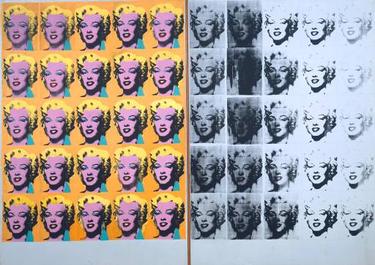The Absurdity of Now: A Critique of Hyperreality and Fragmented Identity in Kelly McDermott’s Multidisciplinary Art
by Carlo Borloni

american dream or american scheme?, bykellymcd
In The Absurdity of Now, Kelly McDermott presents a profound and multifaceted inquiry into the ironies and paradoxes of contemporary existence. Through a deliberately eclectic and bold aesthetic, McDermott's work juxtaposes vibrant colors, symbolic imagery, and a nostalgic nod to American iconography to interrogate the commodification of identity, the digital fragmentation of self, and the erosion of authenticity. This collection resonates deeply with art historical movements that have likewise sought to expose the ambiguities and deceptions embedded in societal values, rendering McDermott's approach both timely and steeped in a critical lineage. By drawing upon the visual languages of Surrealism, Pop Art, Social Realism, and New Media Art, McDermott positions her critique within a broader historical discourse that questions the structures of perception, consumption, and selfhood in modern society.
The Surrealist Influence: Symbolism, Irony, and the Fragmented Real
The symbolic language McDermott deploys in The Absurdity of Now draws an unmistakable line to the legacy of Surrealism, a movement that sought to unravel the hidden truths beneath surface reality by way of paradox, irony, and symbolic dissonance. Like the surrealists, McDermott constructs a visual syntax that leverages contradiction as a means of probing the psychological and cultural fissures within contemporary life. Her fragmented, sometimes disorienting compositions echo the works of René Magritte, where the familiar and the mundane are rendered strange, disconcerting, and ultimately revelatory. By situating recognizable symbols within unfamiliar juxtapositions, McDermott employs Surrealism's strategy of estrangement to dissect the ways in which digital hyperreality has estranged us from the tangible, and indeed the authentic. Her visual language encapsulates the contemporary psyche's struggle to reconcile an ever-increasing reliance on mediated experience with a yearning for genuine self-expression.

The Son of Man, René Magritte
In McDermott's work, the surrealist tension between the real and the imagined is intensified by the digital age's propensity for hyperreality. Her symbolic choices—fragments of Americana, twisted Western motifs, and jarring references to technological artifacts—demand viewers to confront the layered nature of existence today, in which cultural, social, and personal identities are increasingly constructed, commodified, and consumed in fragmented, disjointed forms. This approach echoes the surrealist endeavor to probe the subconscious, yet McDermott's compositions extend this probing into the collective digital psyche, questioning the underlying motivations and anxieties that drive our engagement with hyperreal selfhood.
Pop Art and the Critique of Consumer Culture
Through a vibrant, high-contrast aesthetic, McDermott's work channels the sensibilities of Pop Art, particularly as exemplified by Andy Warhol and Roy Lichtenstein. Like these pioneers, who critiqued consumer society through the ironic use of mass culture symbols, McDermott engages in a dialogue with the present-day culture of instant gratification and commodification. Her exploration of themes such as “privacy as product” and “activism as fashion” speaks directly to the ways in which contemporary society has repurposed personal and ethical ideals for consumption. However, McDermott takes this critique a step further by addressing the digital marketplace of identity, wherein even the most intimate facets of self are objectified and exchanged.

Marilyn Diptych, Andy Warhol
McDermott's strategic use of bright colors and eye-catching forms operates not merely as an aesthetic device, but as an invitation to consider the dichotomy between appearance and substance. Like the Pop Art works that repurposed the familiar with an ironic distance, McDermott's collection entices viewers with alluring visuals that, upon closer inspection, reveal a more subversive narrative. Her work, however, diverges from the original Pop Art movement by situating its critique in an era of digital hyper-consumption, where selfhood itself has become a brand. In McDermott's hands, the appeal of Pop Art transforms into a biting commentary on the superficiality and performativity that underpins the digital economy of identity.
Social Realism and the Influence of Edward Hopper: A Contemporary Solitude
The desolate spaces and isolated figures within McDermott's work also invoke the ethos of Social Realism, particularly the atmospheric, melancholic qualities seen in Edward Hopper. While Hopper's work captured the isolation and existential unease of an industrializing America, McDermott's scenes evoke a distinctly contemporary solitude, one rooted in digital alienation and virtual disconnection. Her figures and landscapes, with their nods to both the American frontier and modern urban desolation, serve as metaphors for the paradox of connectivity in a digital age that fosters both hypervisibility and profound disconnection.

House With Big Pine
Through her rendering of digital alienation, McDermott situates herself in a modern continuum of Social Realism, albeit one that has evolved to encompass the unique contours of 21st-century life. The figures in her works, seemingly connected yet profoundly isolated, reflect a societal condition in which self-presentation is meticulously curated yet devoid of genuine interaction. Her invocation of Western iconography, symbols of rugged individualism and pioneering spirit, highlights the irony of contemporary individualism, in which the outward expressions of selfhood are increasingly mediated and constrained by virtual platforms. Through these themes, McDermott revisits and updates Hopper's exploration of urban loneliness, presenting a new vision of solitude in an era defined by social media.
New Media Art: The Fragmented Digital Self and the Commodification of Identity
McDermott's work further aligns with the legacy of New Media Art, drawing parallels to artists such as Nam June Paik, who utilized emerging technologies to explore the transformative effects of media on identity and perception. By incorporating elements of digital iconography and fragmented visuals, McDermott engages with the notion of the self as a digitized, commodified entity. In an age where identity is continuously reshaped and marketed, her work examines the implications of a selfhood that exists in flux, balancing empowerment and objectification, authenticity and performance.

Electronic Superhighway: Continental U.S., Alaska, Hawaii, Nam June Paik
Her pieces function as a critique of the mediated self, wherein personal identity has become a site of both expression and commodification. McDermott's fragmented compositions, laden with references to both historical and digital artifacts, underscore the complexity of navigating identity in an era where the lines between personal and public, private and performative, are perpetually blurred. This approach situates her within a tradition of New Media Art that questions the ramifications of technological mediation, yet she extends this inquiry to the specificities of modern hyperreality, where the individual is simultaneously celebrated and subsumed by a culture of incessant self-presentation.
A Visual Examination of a World in Contradiction
In The Absurdity of Now, Kelly McDermott constructs a profound commentary on the contradictions inherent in contemporary life. Her work does more than critique digital culture; it interrogates the erosion of genuine values in an era defined by simulation and spectacle. This collection does not offer prescriptive answers but rather invites viewers to contemplate a world increasingly shaped by screens and simulations, one where even the concepts of democracy, environmental urgency, and personal identity are subjected to the logic of instant gratification and performative care.
pandemic or profiteering?, bykellymcd
McDermott's art operates as both an invitation and a confrontation, a reflection of a society steeped in contradictions, yet unrelentingly drawn to the allure of the artificial. Through her multidisciplinary approach, she challenges us to reconsider the nature of identity, the concept of progress, and the meaning of authenticity in a world driven by the consumption of image and illusion.
Sign up for our newsletter to keep up with the latest news from NINFA
Sign up for our newsletter to keep up with the latest news from NINFA
Write us at: info@ninfa.io, or click here if you need support
Copyright © 2025 Ninfa Labs - 12094240962 - All rights reserved

